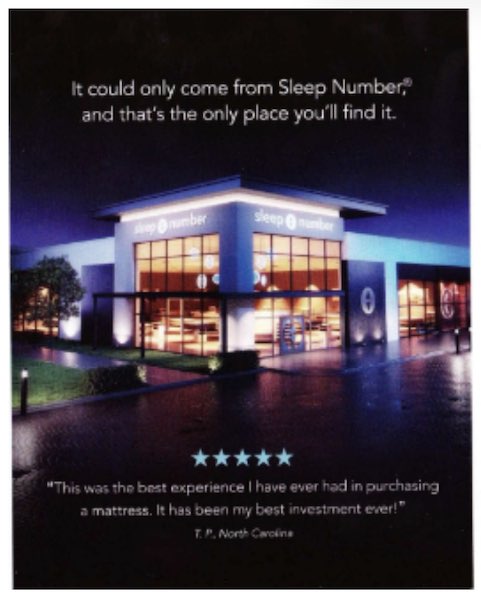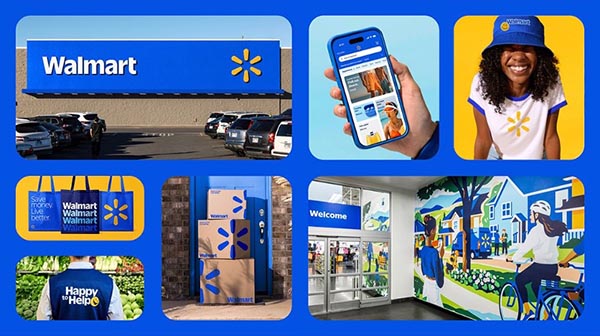It’s not often that you hear major brands talking about their use of direct mail retargeting, but that’s exactly what Sleep Number did at the Customer Relationship Management Conference (CRMC) 2022 in Chicago. Lisa Erickson, senior director of CRM and loyalty for Sleep Number (who likes to open conversations by saying that her Sleep Number setting is 40) was interviewed by Joe Keenan, editor in chief of Total Retail, for the publication’s podcast, “Total Retail Talks.”
In the podcast, Erickson describes how Sleep Number is highly focused on building customer relationships, and that starts the moment someone visits their website. This is the case, even before Sleep Number knows who they are. The company is doing this through direct mail retargeting.

Source: Who’s Mailing What!
Sleep Number has been running direct mail retargeting programs for the past four years and recently ramped up its investment after switching to a new provider, NaviStone. The platform allows Sleep Number to personalize its retargeted direct mail based on site visitors’ browsing habits.
How does it work?
- NaviStone provides its customers’ IT teams with a short matching code, a single line of Java script to insert on each designated page of its website.
- Data is stored in a secure environment specific to each customer, and website visitors are scored on their likelihood to respond by using unique algorithms developed by NaviStone.
- When website visitors show an intent to purchase based on this modeling process, the customer secures postal names and addresses to include in its direct marketing prospecting and reactivation programs.
- NaviStone uses a third-party data partner to connect the visitor ID to a name and address, which is forwarded directly to the customer’s printer or data services provider (in this case, SG360). Neither NaviStone nor the customer takes possession of the name and address of the site visitor, assuring the website visitor’s anonymity.
For more on NaviStone’s consumer data privacy practices, click here.
Tagging Web Pages Most Likely to Convert
Ultimately, Sleep Number’s goal is to move people from their website into a physical store. “Everybody starts the process online,” says Erickson. “You get to our website, and there is a lot to learn about the product. But ours is a product that you want to talk to someone about and try for yourself.”
To move prospects toward that end, Sleep Number began identifying which web pages were most likely to indicate the visitor’s likelihood to convert, then worked with SG360 to tag those pages. The NaviStone platform then matches these anonymous visitors with home addresses, and within three days of their visit, recipients receive a direct mail piece inviting them to come into the store. “There are no promotions. Just invitations to come in,” says Erickson. “That was our goal—let’s just see if it works.”
It does work. Sleep Number is seeing 44% incremental sales rates.
Note: With any direct mail retargeting program, recipients stay anonymous to the retargeter until they act on the offer. In Sleep Number’s case, once someone comes into the store, they can track that interaction back to the direct mail piece.
Getting the digital team’s buy-in for direct mail retargeting required building a compelling business case. Once successes started rolling in, however, Erickson describes keeping direct mail retargeting in the budget as “quite easy.” “I really credit my CRM team with finding ways to do even more of this on a tight budget,” she says. “This includes looking at different formats to reach more of these customers.”
Erickson remains amazed by how quickly Sleep Number’s direct mail retargeting program has taken off. “It’s about having the right partner,” she says. “We had been doing retargeting for years, but we didn’t see the conversion rates we’re seeing now.”
From Retargeting to Loyalty Program
Once someone makes a purchase, Sleep Number attempts to move the customer into its loyalty program, where it keeps them engaged with highly personalized content. Long-term customer retention might seem like a pipe dream for a mattress company, considering that people only purchase new mattresses every 8-10 years. But when customers do make that purchase, Sleep Number wants it to be from them.
For Sleep Number, it’s also about what it calls the flywheel effect. “The number one reason people buy one of our mattresses is because they know someone who has one,” Erickson explains. “Getting a direct mail piece right away, then getting them into the store, [helps to drive that] flywheel effect. [Once they make a purchase,] we keep that relationship going.”
This relationship is maintained, in large part, through Sleep Number’s highly personalized retargeting and loyalty direct mail programs. “You keep hearing people say, ‘direct mail is dead, direct mail is dead,’ but direct mail is a huge differentiator for us,” says Erickson.
Sleep Number has a huge base of insiders, and the company knows that direct mail works with this group. “We know their names, if they are in our inner circle rewards program, and if so, whether they have open rewards to spend with us,” Erickson explains. “We also know what products they’ve bought. We’re doing a test now that shows customers products related to the bed they bought, specifically.”
Sleep Number’s direct mail program works alongside its digital channels, and all of these channels are carefully integrated. Regardless of which channel is used, however, there is one common thread: “Every time we do something at a more personalized or individualized level,” Erickson concludes, “sales go up.”









